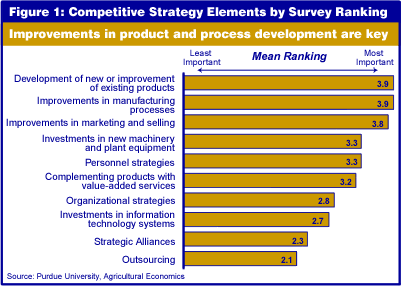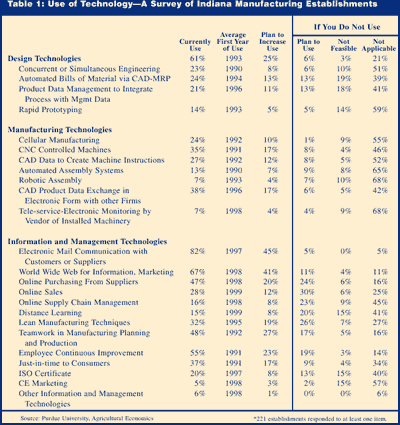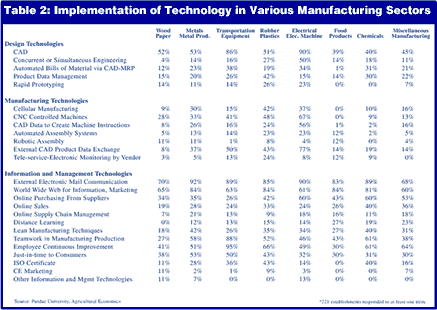Integration of Technology Into Indiana Manufacturing
The manufacturing industry in the United States is continuing a decades-long transformation from stockpile-inventory based production planning to a faster, more efficient production that involves information technology systems and decision tools. Worldwide competitive pressures are driving the industry to adopt new technologies to remain competitive. Computers as accounting batch processors have evolved into information technologies or conduits that connect consumer demand to the elements of manufacturing design, production and management.
Supply chain technologies and lean manufacturing techniques (reducing the time from customer order to manufacturing and delivery of products by eliminating non-value added waste in the production stream) are improving production flow and just-in-time systems. Computer aided design technologies are improving the link from the engineer's office to the factory floor. The future success of individual manufacturing establishments may very well depend upon their ability to adjust to and implement new technologies for competitive advantage. Establishments are increasingly challenged by the need to keep up with advancing technology and to meet increasing demands for efficiency in the global marketplace.
For a glimpse into how Indiana manufacturers are meeting these new challenges, the Department of Agricultural Economics at Purdue University -with assistance from the Indiana Manufacturing Association and the Indiana Economic Development Council-surveyed a random sample of 1,401 of the state's 9,673 (1) manufacturing establishments (2). Of the randomly selected establishments, 236 completed and returned portions of the survey.
The responses provide insight into how manufacturers have implemented advanced technologies. There are three basic areas in which information technologies are being implemented: design, production and administration.
Technologies Manufacturers Are Using
In the implementation of design technologies, the majority of respondents (61%) indicated they were currently using CAD (computer aided design) for engineering and design processes (see Table 1). Twenty-five percent of respondents planned to increase their use of CAD. The average first year of CAD use was 1993, an indication that CAD was seen by companies as a useful design tool early on. Concurrent or simultaneous engineering also had early adoption among users (1990) but was implemented in only 23 percent of the surveyed manufacturing establishments. Design technologies such as rapid prototyping, and associated applications such as automated bills of material from CAD-MRP (material requirements planning) and product data management, have been implemented by a minority of establishments.
Among manufacturing technologies, computer numerical control (CNC) machines had a 35 percent rate of adoption. Thirty-eight percent of establishments were using CAD in the production process to communicate product data with other firms. About one-fourth of establishments in the survey use cellular manufacturing (the arrangement of people and equipment into efficient, process based cells, to create a smooth flow that shortens the lead time for delivery while supporting low inventory production, space saving and continuous improvement), and about one-fourth use CAD data for machine instructions. Thirteen percent had automated assembly systems, but few (7%) used robotic assembly or had their equipment monitored online by a vendor (7%). The rate of implementation of manufacturing technologies overall shows that a minority of respondents are using these technologies, but for those who have done so, the average year of adoption was fairly early in the 1990s, and most before 1994. A minority of establishments planned to increase use of any one particular manufacturing technology.
Information and management technologies saw widespread use of the Internet for e-mail and marketing information purposes. The majority (82%) of respondents use e-mail to communicate with their customers. The average first year of use for e-mail was 1997, and use of the World Wide Web to provide information and marketing began in 1998. Sixty-seven percent of the respondents use the World Wide Web for information and marketing. Forty-five percent plan to increase their use of e-mail; 41 percent plan to increase their use of the World Wide Web.
Approximately half of survey respondents participate in employee continuous improvement (a program that provides ongoing training and development for production and other workers) and use teamwork production. Nearly half buy online from suppliers; however, 28 percent of respondents sell online and only 12 percent planned to increase online sales.
Technologies Not Implemented By Manufacturers
According to responses in the survey, a common reason for not using a particular technology was because it was not applicable to their business. No one single technology is being planned for future implementation by a majority of establishments. The highest ranked planned future use (30%) was online sales. Lean manufacturing techniques (26%), online purchasing (24%) and online supply chain management (23%) were the next most commonly selected technologies/practices for future use.
Implementation of Technology by Manufacturing Sectors
Different manufacturing sectors will have different needs. For example, CAD is more useful for designing an engine than it is for designing a chemical structure. Table 2 shows the rates of implementation by technology and sector. In general, transportation equipment and electrical manufacturing are technology-heavy sectors; food and chemical manufacturing responses showed less implementation among the categories.
In another part of the survey, manufacturing executives indicated they felt technical progress would be a critical determinant of competitiveness. The highest ranked factors for competitiveness involved product and process development (see Figure 1).

Responses indicate that improvements in the manufacturing process and improvements in product development will determine future competitiveness. Technological improvements typically involve capital investment. Eighty-nine percent of the respondents have made investments in equipment within the last three years.
Indiana manufacturers have demonstrated a willingness to make capital investments. They invest to improve product and processes and to ensure competitiveness via technological progress. Indeed, the Chairman of the Federal Reserve attributes most of the productivity gains of the 1990s to technological progress. Manufacturers will likely continue to make investments in technologies as they have proved to be productive assets.
For additional information, contact Kevin T. McNamara by e-mail at: mcnamara@purdue.edu
Footnotes
- U.S. Bureau of Labor Statistics, Covered Employment and Wages Survey Data.
- U.S. Census Bureau, 1997 Economic Census, A-2 Appendix A Number of Establishments and Companies. A manufacturing "establishment" is defined by the U.S. Census Bureau to be a "single physical location where manufacturing is performed" (a company may have more than one establishment).
Kevin T. McNamara, Professor and David L. Brown, Research Associate,
Department of Agricultural Economics, Purdue University


